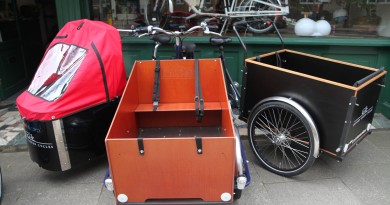Cycling organisations outline priorities for coming years
Wondering what the organisations supporting cycling uptake have been up to since the world began trying to get back to normal, if such a thing exists? The London Cycling Campaign, Sustrans and Bikeability fill CI.N columnist Duncan Moore in on work that has been ticking along in the background to grow cycling rates and safety…
As people took to cycling during Covid lockdowns, to get their fitness fix as gyms and other facilities were closed, was the wider cycling industry able to engage with these people? And have those organisations that were successful in engaging with new cyclists been able to maintain the momentum?
One organisation that saw a positive in Covid lockdowns similar to those experienced by IBDs was the London Cycling Campaign. Dr Ashok Sinha, the LCC’s Chief Executive, says: “Because of restrictions on public transport use during Covid, plus greater interest in cycling (whether as a socially distanced means of transport or as a form of exercise and recreation), LCC was able to recruit more members than usual.
“Growth has continued since the end of lockdown. Our campaigning work to promote the use of quick, short-term measures to substantially increase the mileage of protected cycle tracks, and also to prevent a bounce back of high motor traffic levels in residential areas (low traffic neighbourhoods), also attracted more members.”
It’s a similar story on a national scale with Sustrans reporting that while there was initially, a pause on volunteering activities that it is involved in, which involved leaving the home through the first lockdown, there has been a steady rise in volunteers getting involved. “Since starting back up again [post-lockdown], with measures in place we have seen a steady rise in volunteers getting back involved,” is the comment from a Sustrans spokesperson, who continues, “in regard to recruitment and retention of volunteers, numbers have remained steady.”
While both the LCC and Sustrans might be familiar to long-term cyclists what about those who took up the pastime during lockdown, where did they turn to for help and guidance? One option that many new cyclists may have looked to for help is Bikeability, but it too was hampered in its aims to get people cycling by the impact of national lockdowns.
“During the first lockdown, Bikeability cycle training stopped in order to comply with Covid restrictions when schools were closed,” explains Emily Cherry, CEO, The Bikeability Trust. “However, behind the scenes, we worked hard to get cycle training up and running again. From July 2020, we worked with Department for Transport, Department for Education and Public Health England teams to issue Bikeability Covid guidance. This was regularly updated to reflect national guidance. It meant that from July 2020, Bikeability was able to continuously offer cycle training as an outdoor activity to children in schools. This included ensuring children of key workers who were in school during subsequent lockdowns were able to access our cycle training.
“With both the 2019/20 and 2020/21 academic years interrupted by lockdowns and school closures, delivery statistics are lower than usual. Between April 2020 and March 2021, 140,470 children received Department for Transport funded Bikeability training.
“As restrictions eased, delivery returned to normal. We will release accurate delivery statistics for April 2021 to March 2022 in July 2022, but levels have returned to record levels of children receiving training, with hundreds more families taking up our family training after discovering cycling together during the pandemic.”
Now that life is returning to ‘normal’ how are these organisations faring, have they been able to continue to prosper? Sinha says of the LCC “We have seen growth in our membership and income and have been able to expand our campaigning capacity.”
Climate Safe Streets and Dangerous Junctions campaigns are the LCC’s current priorities, with the former targeting a full decarbonisation of London’s roads by 2030, calling on London’s political leaders to pursue a mass shift from cars to cycles for short journeys, as well as provide enhanced public transport and make shared mobility easily options available to all.
Sinha also says that the LCC “has long called for such action but the climate emergency demands accelerated delivery”.
Then the Dangerous Junctions campaign, which is a long-standing priority for the LCC, as junctions are the most dangerous locations for cycling (and walking) and action to remediate this has always been inadequate, according to Sinha.
“Campaigning aside, we are also continuing and further expanding the programmes we set up during Covid to help people directly, such as our Cycle Buddies project that pair less confident with experienced cyclists to help the former cycle more, and more enjoyably,” Sinha continues as he explains how the organisation is moving on post-Covid.
It is a similar story of picking up on previous policies and carrying on post-Covid for Bikeability, where with a record £20 million of investment from the Department for Transport in 2022-23, Cherry notes that “we will continue to work towards our ambition to offer every child cycle training by 2025. This record investment will allow us to reach more children and, importantly, their families too.”
The work being undertaken by these organisations to pro-actively get more people cycling more often can only be a good thing for IBDs as more people on bikes should equate to more sales and service work.
“The pandemic saw quite a visible surge in walking, wheeling and cycling from the public with 121 million more trips on the NCN in 2020 than in 2019,” says Sustrans’ spokesperson. “There was a £2 billion investment in walking, wheeling and cycling initiatives from the government in 2020 and in 2022 the launch of Active Travel England. The Department for Transport also confirmed a further £35million in funding to improve the quality, safety and accessibility of the NCN, and part of the Paths for Everyone programme.”
So, there’s certainly plenty of money set to come into the industry and it is already impacting suppliers as Cherry says: “We’re building our partnerships with commercial partners. We’re already working with the likes of Frog Bikes, Forme, Bike Club and Beryl Bikes to give people more than just a Bikeability session.
“In the year ahead, we will continue to work with other cycling organisations to raise the profile of Bikeability and to build a library of offers and deals that our trainees can take advantage of after their cycle training. By working in collaboration, we can reach far more children and families and build more of a momentum for cycling across the country.”
Now it just needs the wider trade to further engage with organisations such as Bikeability to make cycling accessible and turn those new cyclists into regular customers.



